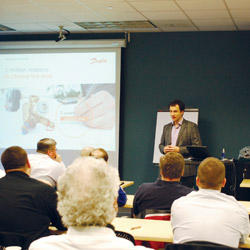
|
| Miha Kavcic, product portfolio director, Danfoss, uses a demonstration panel mimicking a real heating and cooling application in a multistory building during a recent seminar. |
BALTIMORE — Danfoss Inc. recently held the first in a series of regional seminars on the new Danfoss AB-QM pressure independent control valve (PICV) at its training center. More than 40 consulting engineers attended to learn the benefits associated with the product, including its ability to offer substantial energy savings.
The PICV blends two conventional system components, the balancing valve and the control valve, into one compact valve to provide a cost-effective means to ensure design flow at each terminal coil regardless of system differential pressure fluctuations. According to Danfoss, achieving design flow at all times results in better control and comfort levels, as well as energy savings since overflow conditions are eliminated.
Led by Miha Kavcic, product portfolio director, Danfoss, the event included a professional demonstration panel that mimicked a real heating and cooling application in a multistory building. The application is set up to be controlled by both a traditional valve setup, including manual balancing valves or flow-limiting valves, and by AB-QM PICVs in order to show the difference in performance. The demonstration panel is fully supported by software so that seminar participants see changes in flow and pressure in real time.
Participants also input their own values, representing system pressure, system load, and more to see and compare system performance between a traditional design and an AB-QM design in a way that was relevant to their line of work.
“We developed this seminar to substantiate with consulting engineers the significant improvements in control and energy use that this technology provides to commercial buildings,” said Lyle Moroz, divisional vice president, Danfoss. “The demonstration panel used in the seminar really helps to drive home this point, and we received great feedback about the effectiveness and relevance of this approach.”
Publication date: 05/14/2012

Report Abusive Comment